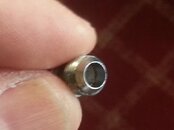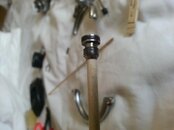Without implying that you don't already know most of this, I have a couple of comments re: your order of tuning:
- During assembly I adjust the balance adjustment insert so that it is flush with the adjustment knob sleeve.
- Then I adjust the orifice during diaphragm assembly so that the lever just touches the diaphragm with the user adjustment knob all the way out
I'm OK with your first statement, but the second has me a little confused.
In the S600,
assuming the balance chamber adjustment knob and spring is not so far out that it's not exerting any force against the poppet, the ONLY determinant of lever height is the position of the orifice. The adjustment knob then only affects cracking effort.
If you can adjust the lever so it's TOO high before the orifice separates from the new seat, then you'll actually need to bend your lever (tough to do without the lever height tool). Otherwise, the only way to drop the lever is to screw in the orifice, which will not allow you minimum cracking effort.
With a new seat, it's possible for it to be just slightly too high, because it hasn't set a groove in the seat yet. It's common for a perfectly adjusted new seat regulator to start leaking a couple of weeks later, as the orifice sits on the seat and effectively lessens the sealing pressure. 1/12 to 1/4 turn in on the orifice usually fixes it. That's why techs will "detune" your reg 1/12 turn (1 hour on the clock), after inserting a new seat, to make up for that future change. I'm assuming you know this and am really writing for others reading this post. In your case, the only real direction the lever should go is down. At it's highest point, set the diaphragm in place and see how much tapping room you have. If it's less than 1/32", then the diaphragm will probably cause the reg to freeflow when you screw down the case. If there's more than a little play, then your lever needs rebending, or you'll never seal without lots of slop.
A couple of questions:
1) When you replaced the seat, are you SURE it's absolutely flat where it tucks into the white poppet? That could be one cause of variable sealing after multiple adjustments. Are you sure the poppet is installed with the lever lugs in the correct orientation? (Sorry if these are stupid questions)
2) When you tuned it, did you remember to depress the lever/purge button as you adjusted cracking effort? If not, you may have cut the seat a little, again leading to variable leaks.
Since I'm assuming that you didn't have an issue with #1 or #2, then lever height corresponds to orifice position against the seat. The further in the orifice is screwed, the lower/sloppier the lever gets.
With the diaphragm off, and the adjustment knob screwed in halfway or more (to ensure you have firm spring pressure against the poppet), I would back out the orifice a little at a time (depressing the lever with each 1/8-1/4 of a turn), until lever height reaches its maximum, then back in 1/12 turn. Then with the LP hose off, blow thru the hose fitting. Did it seal to lung pressure? If not, despite firm spring pressure from the adjustment knob, add in 1/12 turn at a time until it seals. Then do a quick check of lever height versus the diaphragm as above.
If, with firm spring pressure the orifice doesn't seal within 1/4 turn, then you either have a leak at the orifice o-ring, a leak at the orifice knife edge, or a leak at the seat from malposition, a cut or a defect. Those are the ONLY possibilities. The orifice o-ring is a common one for leaks that just can't get diagnosed.
If you can seal to lung pressure with 1/12 to 1/4 of a turn in on the orifice, start backing off on the adjustment knob while watching the lever. If it drops at ANY time before you reach fully screwed out, then you have two possibilities: 1) either the spring is weak or short (or effectively short because its ends are in worn grooves in the plastic balance chamber or the poppet). 2) I think the more likely cause of the whole lever issue might be that the little lugs on the white poppet that engage the tabs are worn or dinged. The metal lever is harder than the plastic poppet, and a lot of mechanical advantage is applied over and over on that one spot. See if you can see a ding in the lugs on the duro poppet. If so, your lever will never get as high as it could otherwise, even with the orifice barely touching. A new poppet's an easy $17 replacement on EBay.
If you can back out on the adjustment knob without having the lever drop at all, then you can fine-tune the cracking effort by attaching your LP hose and applying the full 135psi. You'll leak for sure after just testing to lung effort, but that should disappear within 1/2 turn of the orifice. Once sealed at IP, you can return to your adjustment knob. I wouldn't be unhappy with tiny free-flow fully screwed out, since that is one way you can increase the longevity of your seat in between dives, the way Sherwood recommends for their adjustables. In any case, going for 0.5" cracking effort is more than the case geometry of that regulator can allow. Sure, it'll breathe with a whisper horizontally, but it will free-flow slightly whenever you're looking down (like, most of the time). That case won't permit less than about 0.8" of cracking effort and not free flow in at least some positions.
Bottom line? I'm with halo, that if it's not an actual leak at the orifice, seat or o-ring, it's a spring issue. Either an actual spring weakness/shortening, or effectively a spring issue due to balance chamber or poppet lug wear. If it is a tiny ding in the plastic orifice, you can even find an old metal one and dress it with 4,000 to 8,000 grit Micro-mesh. You'll lose the chrome on the knife edge and make it more susceptible to corrosion, but it will seal like a dream.
To push that orifice out, there is a TINY ledge inside.

It reduces the diameter just below 3/16", so a 3/16" dowel from the hardware store will catch perfectly without touching the knife edge itself. The actual max diameter of your homemade push tool is 0.19"/4.85mm without touching the knife edge.

Good luck!






